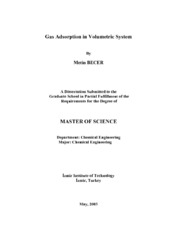Please use this identifier to cite or link to this item:
https://hdl.handle.net/11147/3778Full metadata record
| DC Field | Value | Language |
|---|---|---|
| dc.contributor.advisor | Özkan, Seher Fehime | en |
| dc.contributor.author | Becer, Metin | - |
| dc.date.accessioned | 2014-07-22T13:52:21Z | - |
| dc.date.available | 2014-07-22T13:52:21Z | - |
| dc.date.issued | 2003 | en |
| dc.identifier.uri | http://hdl.handle.net/11147/3778 | - |
| dc.description | Thesis (Master)--Izmir Institute of Technology, Chemical Engineering, Izmir, 2003 | en |
| dc.description | Includes bibliographical references (leaves: 87-90) | en |
| dc.description | Text in English; Abstract: Turkish and English | en |
| dc.description | x, 90 leaves | en |
| dc.description.abstract | In this study, nitrogen adsorption on natural zeolitic tuff from Gördes, (Fındıcak) region and on its acid treated forms was studied. The natural zeolite, identified as clinoptilolite, has been treated with HCl, H2SO4, HNO3, and H3PO4 solutions at several concentrations to obtain the acid treated forms. Structural modifications arising from the acid treatments were determined by the techniques, namely XRD, FTIR, ICP, EDX, SEM, DTA, TGA, and microcalorimeter. Adsorption characteristics of zeolites, such as external and total surface areas, micropore volumes and pore size distributions were compared.Acid treatment of natural zeolite showed that as the acid concentrations were increased, more cations were removed from the structure, changing the Si/Al ratios from 4.04 (original zeolite) to 5.35 with H2SO4, to 6.39 with HNO3, to 10.8 with HCl and to 5.01 with H3PO4 treatments respectively. With acid treatment, the maximum nitrogen adsorption capacity at P/Po . 0.89 of natural zeolite (0.015 cm3/g) was increased to 0.089, 0.090, 0.086, and 0.050 cm3/g for HCl, HNO3, H2SO4 and H3PO4 treatments respectively. Nitrogen adsorption capacities of the zeolites increased with increasing Si/Al ratios, but further increase in concentrations caused to decrease the adsorption capacity for HCl and HNO3 treatments. HCl behaved in a different way that, dilute (1M) and highly concentrated (10 M) solutions has effect on the framework structure much more than the middle range concentrations (3 M and 5 M HCl) decreasing the nitrogen adsorption after Si/Al . 8.4 (5 M HCl).Dubinin-Raduskhevich model was used to determine the volume accessible to nitrogen (limiting micropore volume). It increased with increasing Si/Al ratios, but further increase in concentrations caused to decrease in microporous structure. The highest limiting micropore volumes (0.078 and 0.082 cm3/g), and Langmuir surface areas (213 and 226 m2/g) were obtained with the 5 M HCl and 2 M HNO3 treated samples respectively without any noticable loss in crystallinity. | en |
| dc.language.iso | en | en_US |
| dc.publisher | Izmir Institute of Technology | en |
| dc.rights | info:eu-repo/semantics/openAccess | en_US |
| dc.subject.lcc | TP156.A3 B43 2003 | en |
| dc.subject.lcsh | Gases--Absorption and adsorption | en |
| dc.subject.lcsh | Zeolites--Absorption and adsorption | en |
| dc.title | Gas adsorption in volumetric system | en_US |
| dc.type | Master Thesis | en_US |
| dc.institutionauthor | Becer, Metin | - |
| dc.department | Thesis (Master)--İzmir Institute of Technology, Chemical Engineering | en_US |
| dc.relation.publicationcategory | Tez | en_US |
| item.openairecristype | http://purl.org/coar/resource_type/c_18cf | - |
| item.cerifentitytype | Publications | - |
| item.fulltext | With Fulltext | - |
| item.languageiso639-1 | en | - |
| item.grantfulltext | open | - |
| item.openairetype | Master Thesis | - |
| Appears in Collections: | Master Degree / Yüksek Lisans Tezleri | |
Files in This Item:
| File | Description | Size | Format | |
|---|---|---|---|---|
| T000256.pdf | MasterThesis | 1.29 MB | Adobe PDF |  View/Open |
CORE Recommender
Page view(s)
156
checked on Apr 15, 2024
Download(s)
52
checked on Apr 15, 2024
Google ScholarTM
Check
Items in GCRIS Repository are protected by copyright, with all rights reserved, unless otherwise indicated.